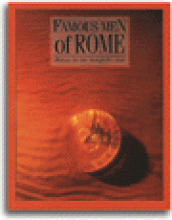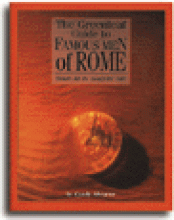Ancient Rome Biographies
Famous Men of Rome
Subject(s):
Setting:
Grade / Age level:
Review:
Our first year of homeschooling we used a dry textbook for American history. Well, we didn't really use it - we put it off as much as possible and the year passed with only the first few chapters read.
Our second year of homeschooling, we discovered Greenleaf's Famous Men series (through enrolling in the Kolbe Academy Home Study program). What a difference! It was our first exposure to literature-based history study, and the idea of studying time periods through "real books" was a formative one in our homeschool.
Famous Men of Rome was written very early in the 20th century and revised by Rob Shearer of Greenleaf Press. Its operating principle is that history is not primarily about dates and facts; it is about the lives and actions of people. Consequently, it is divided into a series of "Lives", chronologically arranged, simply and memorably telling of the lives and choices of leaders and great men in the history of Rome.
There are thirty chapters in the book, starting with Rome's origin according to legend: the story of Romulus and Remus and their upbringing by a wolf, which became the symbol of Rome's self-identity in its later years. The rest of the book focuses on one historical "famous man" per chapter, with approximate dates of their lives. The stories are told as tales of virtue and vice and how individual actions and characters can affect history, not as dry collections of historical facts to memorize. My highschooler still remembers, from fifth grade, Horatio at the bridge and Cicero ending every speech to the Senate with "And Carthage must be destroyed!" The chronological range of the book is from 753 BC, the estimated founding of Rome, to 476 AD, the end of the Western Empire as Italy became a barbarian kingdom under the rein of Odoacer.
Though the stories in Famous Men of Rome are almost always very interesting, the writing style is quite simple. This might be a drawback to some families who prefer a more literary, complex style. But it does mean that an average 5th grader can read with comprehension and focus on content and meaning. Another possible criticism might be that taken by themselves, the Lives give a sort of scattershot perspective of the course of history - like a slideshow compared to a video. However, in my view the biographical presentation gives history more meaning and interest, and also allows us to compare and contrast the characters of these great men and see how their actions influenced their times.
The book is probably targeted to a third to seventh grade level. It makes an excellent read aloud, but can also be read independently. Kolbe Academy uses it for the history spine in fourth grade. An older student could read the book as an informative supplement to primary source reading in junior high to high school.
Our second year of homeschooling, we discovered Greenleaf's Famous Men series (through enrolling in the Kolbe Academy Home Study program). What a difference! It was our first exposure to literature-based history study, and the idea of studying time periods through "real books" was a formative one in our homeschool.
Famous Men of Rome was written very early in the 20th century and revised by Rob Shearer of Greenleaf Press. Its operating principle is that history is not primarily about dates and facts; it is about the lives and actions of people. Consequently, it is divided into a series of "Lives", chronologically arranged, simply and memorably telling of the lives and choices of leaders and great men in the history of Rome.
There are thirty chapters in the book, starting with Rome's origin according to legend: the story of Romulus and Remus and their upbringing by a wolf, which became the symbol of Rome's self-identity in its later years. The rest of the book focuses on one historical "famous man" per chapter, with approximate dates of their lives. The stories are told as tales of virtue and vice and how individual actions and characters can affect history, not as dry collections of historical facts to memorize. My highschooler still remembers, from fifth grade, Horatio at the bridge and Cicero ending every speech to the Senate with "And Carthage must be destroyed!" The chronological range of the book is from 753 BC, the estimated founding of Rome, to 476 AD, the end of the Western Empire as Italy became a barbarian kingdom under the rein of Odoacer.
Though the stories in Famous Men of Rome are almost always very interesting, the writing style is quite simple. This might be a drawback to some families who prefer a more literary, complex style. But it does mean that an average 5th grader can read with comprehension and focus on content and meaning. Another possible criticism might be that taken by themselves, the Lives give a sort of scattershot perspective of the course of history - like a slideshow compared to a video. However, in my view the biographical presentation gives history more meaning and interest, and also allows us to compare and contrast the characters of these great men and see how their actions influenced their times.
The book is probably targeted to a third to seventh grade level. It makes an excellent read aloud, but can also be read independently. Kolbe Academy uses it for the history spine in fourth grade. An older student could read the book as an informative supplement to primary source reading in junior high to high school.
Reviewed by:
First reviewed:
7-19-04
Galen and the Gateway to Medicine
Subject(s):
Setting:
Grade / Age level:
Review:
Jeanne Bendick's second title in Bethlehem Books' "Living History" series (after Archimedes and the Door of Science) brings to life the 2nd century (A.D.) Roman doctor whose work in learning to understand the human body became the standard authority on human physiology for over a thousand years. Although many of his theories were corrected through advancements in science since the middle ages, his story is interesting both for its own sake and for the light is sheds on Roman history and culture and the Hippocratic tradition of medicine.
Galen was born in 129 A.D. in present day Turkey (at that time part of the Roman Empire). When he studied medicine, medical training was very haphazard, but in his lifetime he revolutionized the idea of what a doctor should be, both by his example as a renowned doctor and his extensive writings on anatomy and pharmacology (some of which are still in existence today). His experience in treating patients from wounded gladiators to the wealthy of Rome to Roman emperors, extensive study of medicinal plants, dissection of animals, etc. led to his remarkable success as a doctor and the respect with which his writings were treated.
The medical aspects of the book largely focus on the quest to understand the purpose of each of the organs and the workings of the circulatory system. The author also provides us with a final chapter which summarizes the medical advancements after Galen that led to our current understanding of how the body works. Like Archimedes and the Door of Science, this story will be best understood by ages ten and up and takes a certain amount of concentration to follow the story and absorb its content well. However, the rewards are great in acquiring a deeper understanding of Roman culture, medicine, and the respect for life that has been passed down from the Hippocratic tradition.
Galen was born in 129 A.D. in present day Turkey (at that time part of the Roman Empire). When he studied medicine, medical training was very haphazard, but in his lifetime he revolutionized the idea of what a doctor should be, both by his example as a renowned doctor and his extensive writings on anatomy and pharmacology (some of which are still in existence today). His experience in treating patients from wounded gladiators to the wealthy of Rome to Roman emperors, extensive study of medicinal plants, dissection of animals, etc. led to his remarkable success as a doctor and the respect with which his writings were treated.
The medical aspects of the book largely focus on the quest to understand the purpose of each of the organs and the workings of the circulatory system. The author also provides us with a final chapter which summarizes the medical advancements after Galen that led to our current understanding of how the body works. Like Archimedes and the Door of Science, this story will be best understood by ages ten and up and takes a certain amount of concentration to follow the story and absorb its content well. However, the rewards are great in acquiring a deeper understanding of Roman culture, medicine, and the respect for life that has been passed down from the Hippocratic tradition.
Reviewed by:
First reviewed:
2-3-03
Greenleaf Guide to Famous Men of Rome
Subject(s):
Setting:
Grade / Age level:
Review:
The Greenleaf Guide to Famous Men of Rome is an optional supplement for the book. It includes, for each lesson, a vocabulary list and several discussion questions designed to bring out the key points of each biography through a Christian (biblical) perspective. The discussion questions are excellent narration starters and really do help bring out the theme that "individual people and their actions have a significant effect on history". There are some ideas for simple hands-on projects (the first lesson involves making a salt relief map of the country in question to get an idea of how geographical circumstances affect history). There are also suggestions for supplementary reading. I must say their book choices are quite wonderful and that all the books we acquired on Greenleaf's recommendation for ancient history have been treasures. There is also a timeline at the back which is helpful in unifying the various biographies.
Reviewed by:
First reviewed:
7-19-04



